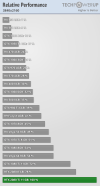100%.
I wouldn't consider myself a hardcore gamer, somewhere between casual and hardcore. FG feels terrible. Maybe it's okay on a 240hz monitor with 120 frames rendered, but going from 60 to 90-100 fps (on my 4080 FG doesn't double the frame rate, it's more like 1.5X - 1.7X) feels worse and less responsive than just playing the game at 60fps, so I always turn it off. I haven't played a single game yet with the feature where I didn't turn it off. The only game that felt somewhat okay with FG that I have played was Black-Myth W, but even in that game I ultimately preferred 60 fps over FG and adjusted my settings accordingly.
It's all marketing.
Most of fledglings do not even know what they are chasing, when speaking performance. Max "ANYTHING" is not performance for the top-tier GPU buyers, it's
Consistency.
Let me explain. I sold my Vaunted SONY (FW900) CRTs and held on to them as long as possible when flatpanel LEDs hit the gaming scene, and even though these new LEDs could do 1080p at 120Hz, their pixel response & signal latency and <
input lag> was 10x greater than the CRT that all of us (at the time) were use to playing on.
It isn't until NOW..
Input lag & pixel response with these new OLED gaming displays, means that Oldschool Gamers can get the feel of responsiveness in games, that we once had. Those exact same SONYs I sold in 2010 are going for $10k a piece now.. because that technology doesnt have latency.
It was never about frames, or even Hz. Multi-sync monitors LOCKED into any pre-set resolution, but @ a constant frequency:
- 1024 x 768 @ 148Hz VESA
- 1152 x 864 @ 148Hz VESA
- 1600 x 1024 @ 120Hz VESA
- 1600 x 1200 @ 85Hz VESA
- 1920 x 1080 @ 120Hz VESA
- 1920 x 1200 @ 85Hz VESA
- 2048 x 1280 @ 85Hz VESA
- 2048 x 1536 @ 75Hz VESA
- 2304 x 1440 @ 60Hz VESA
etc...
Todays monitors are not multi-sync they have a Native resolution/set amount of pixels and can alter their response RATE. Which is something a gamer never really wants, they want CONSISTANCY.
SO when buying a gaming monitor the 1st thing is not Hz, but latency (ie Input lag).
The reason so many of you n00blings are focused on a single metric of MAX FRAMES, is because of MARKETING. While not really grasping the underlying principle of why. The honest truth to every Pro gamer on the planet is not about MAX frames.. it is 100% about avoiding the lowest frames.
example:
Professional don't care if they are hitting 380-420fps... or that someone else is getting 580fps; only that it's not dipping down to 90fps. They are so concerned about lowest frames. Additionally, running your card at 580fps, only to heat soak your GPU 20 minutes into match and have your frames become inconsistent and varied, which is not as good as limited your card to 320fps and keep those frames consistent throughout the match/game sessions.
SO, If you want unfettered gameplay, turn off vsync. Using your monitor as a just display, with no input lag or processing and nothing to get in the way of your gameplay.
Today, any OLED display at 144Hz,
with near zero input lag & GPU able to keep consistent frames above that^ is all that is needed for 99.9% of all gamers.
Lastly,
Ai, frame generation, DLSS, are all gimmicks that introduce latency, all for visual fluff and effect. Great for low input entertainment style games, unnecessary and unwanted in multiplayer/competitive games.


